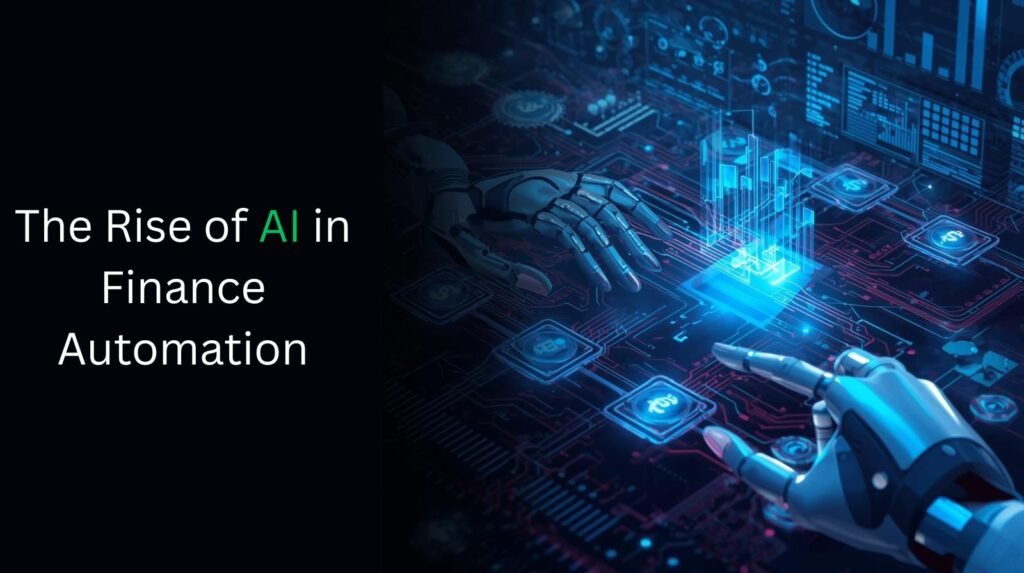
- Why AI in Finance Automation Matters
- Key Domains of AI-Powered Finance
- Intelligent Fraud Detection & AML
- Case Example: Banking Network Use
- Credit Scoring & Risk Assessment
- Case Example: Fintech Lender
The finance industry has always been a crucible for innovation—ledgers, credit risk models, algorithmic trading—and now it stands at the inflection point where AI in finance automation will redefine how money is managed, safeguarded, and grown. From fraud detection and risk scoring to algorithmic trading and personalized services, financial institutions are leveraging predictive banking AI, intelligent fraud detection, and AI for financial analytics to build the next generation of smart, automated fintech ecosystems.
At AixCircle, we see the future of finance not simply as digital banking, but as AI-infused financial intelligence—where fintech AI solutions become the backbone of customer trust, operational efficiency, and strategic differentiation. In this post, we examine how AI is reshaping credit scoring, trading, analytics, fraud prevention, and personalized banking; we illustrate real use cases, discuss benefits and challenges, and paint a visionary roadmap for the future of smart money management.
Why AI in Finance Automation Matters
Financial services operate in high stakes environments—vast volumes of transactions, regulatory compliance pressures, evolving fraud patterns, market volatility, and customer expectations for seamless service. Traditional rule-based systems, manual heuristics, or static models struggle to keep pace. That’s where AI in finance automation becomes essential:
- Scalability & speed: AI models can analyze millions of data points in real time, enabling instantaneous decisions that human or rule systems cannot match.
- Adaptive learning: Rather than rigid rules, AI systems can evolve as markets shift, user behaviors change, or fraud patterns mutate.
- Deep insights & predictive power: Through AI for financial analytics, institutions can forecast trends, detect anomalies, and tailor offerings proactively.
- Cost efficiency & risk mitigation: Automating repetitious tasks, reducing false positives, and improving detection accuracy drives down operational costs and losses.
- Customer experience & personalization: Predictive banking AI enables individualized insights, recommendations, and proactive alerts that enhance engagement and loyalty.
In short, AI is enabling finance institutions to move from reactive systems to predictive, self-optimizing ecosystems.
Key Domains of AI-Powered Finance
Below are the core areas where AI is already transforming financial services:
- Intelligent Fraud Detection & Anti-Money Laundering (AML)
- Credit Scoring & Risk Assessment
- Algorithmic & Quantitative Trading
- Personalized Banking & Wealth Management
- Financial Analytics & Forecasting
Let’s explore each domain in depth.
Intelligent Fraud Detection & AML

Fraudulent behavior evolves rapidly—synthetic identity fraud, account takeovers, insider threats, layering money through complex channels. Traditional rules (e.g. “flag transaction > X amount”) are too simplistic and generate high false positives. What’s needed is intelligent fraud detection powered by AI.
How AI Enhances Fraud Detection
- Anomaly detection & behavioral profiling: Instead of fixed thresholds, AI models learn patterns of “normal” behavior for accounts (transaction amounts, geographic patterns, time patterns) and flag deviations.
- Graph analysis & network detection: Using graph neural networks or link analysis, AI can detect suspicious networks of accounts coordinating fraud or money laundering chains.
- Real-time scoring & decisioning: AI can assign risk scores instantly, allowing systems to block, challenge with verification, or flag for review before settlements.
- Adaptive learning against evolving attacks: As fraudsters shift tactics, AI models retrain themselves to detect novel patterns, reducing the lag behind new threat vectors.
- Hybrid rules + AI models: In practice, you often combine AI detection with business rules, guardrails, and human review to maintain safety and interpretability.
Long-tail usage: “intelligent fraud detection” appears in this section; we will embed more across the blog.
Case Example: Banking Network Use
A bank deployed an AI system that monitors billions of daily transactions. The system flags suspicious clusters of transactions (e.g. funneling small deposits into consolidation accounts) using graph analytics, and intercepts money laundering schemes before they complete. After AI adoption, the bank reduced false positive rates by 40% and cut review overhead by 25%.
Another insurance payments platform used AI to detect fraudulent claims by comparing claim metadata, user behavior, device signals, and relational connections between users. The intelligent fraud detection system saved the company millions annually.
Credit Scoring & Risk Assessment
Traditional credit scoring relies heavily on static factors (credit history, income, collateral). But these models often exclude “thin file” customers or emerging behaviors. Predictive banking AI is enabling smarter, fairer risk assessment.
AI Approaches to Credit & Risk
- Alternative data incorporation: AI systems ingest nontraditional data sources—mobile usage, transaction flows, social signals, utility payments, geolocation data—to enrich scored profiles.
- Machine learning risk models: Gradient boosting machines, neural networks, or ensemble models can identify complex, nonlinear predictors of default that classical statistics might miss.
- Behavioral scoring / dynamic updates: Instead of a static credit score, AI continuously updates a customer’s risk profile based on recent transactions, spending behavior, or macroeconomic signals.
- Explainable AI & fairness constraints: Because credit decisions affect lives, AI models often embed interpretability modules and fairness constraints to avoid discrimination.
- Hybrid governance + algorithmic oversight: Human risk teams audit models, approve thresholds, and monitor drift to ensure compliance and alignment with policy.
Case Example: Fintech Lender
A digital lender used AI in finance automation to build a credit model that included smartphone usage data, payment history, and social graph features. This allowed approval rates to increase for underbanked populations without increasing default rates. The predictive model delivered a 15% lift in new-approved customers and kept nonperforming loan ratios steady.
Another bank integrated AI-driven dynamic risk scoring so that credit line offers to existing customers adapt in real time. Customers with improving patterns received incremental credit boosts, while those showing risk saw gradual reductions—minimizing exposure while boosting loyalty.
Algorithmic & Quantitative Trading
Algorithmic trading has long used quantitative models and statistical signals. But now, AI (especially deep learning, reinforcement learning, time-series neural nets) is injecting new capabilities for prediction, adaptation, and autonomous strategy execution.
How AI Powers Smarter Trading
- Pattern discovery & predictive signals: AI models can detect subtle temporal or cross-asset patterns previously hidden in noise.
- Reinforcement learning & automated strategy adaptation: Agents can simulate trading environments, learn reward structures (e.g. risk-adjusted returns), and adapt strategies dynamically.
- Execution optimization & cost reduction: AI algorithms optimize trade slicing, order scheduling, and venue routing to minimize slippage, latency, and transaction costs.
- Risk and regime detection: AI models can detect regime shifts (volatility spikes, correlations breaking) and adjust models or temporarily pause strategies.
- Multi-agent strategy orchestration: Multiple AI agents may collaborate—one generating signals, another managing portfolio risk, another executing trades—coordinated by a meta-controller.
Case Example: Hedge Fund AI Deployment
An AI hedge fund used deep reinforcement learning to optimize high-frequency execution strategies. The system monitored microstructure signals, anticipated short-term order book imbalances, and adjusted the aggressiveness of orders dynamically. Over time, the fund saw improved execution efficiency and reduced execution cost per trade.
Another quant shop employed AI to discover cross-asset arbitrage signals across currencies, equities, and commodities. The model adapted to regime changes by switching submodels or pausing strategies when volatility thresholds were breached.
Personalized Banking & Wealth Management
Financial institutions are not only guarding assets and assessing risk—they are increasingly enabling proactive, tailored experiences. Fintech AI solutions in personalized banking help to deliver financial advice, budgeting, investment insights, and customer retention.
Features & AI Use Cases
- Personalized insights & proactive alerts: AI monitors spending, balance trends, and upcoming expenses to alert customers (e.g. “You’re likely to overshoot budget this month” or “Your balance is low; consider a transfer”).
- Robo-advisory & portfolio optimization: AI constructs and adjusts portfolios based on risk tolerance, time horizon, and market conditions.
- Goal-based financial planning assistants: Virtual assistants help users set goals (home purchase, education, retirement) and track progress, offering nudges and optimizing allocations.
- Churn prediction & retention modeling: AI identifies customers at risk of churn and triggers personalized offers or re-engagement campaigns.
- Conversational banking interfaces: Chatbots or voice agents respond to balance queries, move funds, recommend options, or alert on anomalies—blending AI for financial analytics with conversational UX.
Case Example: Digital Bank
A neobank integrated an AI engine that tracks customers’ cash flows and sends weekly “health scores” with recommendations (e.g. save more, allocate to investments). The system also nudges users with micro-savings based on surplus cash flows. Engagement metrics rose, and customers reported increased stickiness and satisfaction.
A wealth management platform uses AI to rebalance client portfolios dynamically in response to shifts in market conditions, tax implications, or the client’s changing risk tolerance. It also surfaces educational insights to improve client financial literacy.
Financial Analytics & Forecasting
To power all these domains, institutions need robust AI for financial analytics—capable of predictive modeling, scenario simulation, stress testing, and performance attribution.
Capabilities in AI Analytics
- Time-series forecasting: Deploy recurrent neural nets, transformer models, or hybrid models to predict interest rates, FX movements, portfolio returns, or macro indicators.
- Scenario & stress simulations: Use AI to simulate extreme conditions (e.g. shock to liquidity, regulatory change, crises) and analyze portfolio resilience.
- Attribution & causal inference: AI methods help decompose performance back to drivers—market factors, asset contributions, stylistic effects—supporting strategic decisions.
- Anomaly detection in financial flows: Detect outlier behavior in cash flows, balance sheets, or accounting entries.
- Dashboarding & decision support: AI pipelines feed into dashboards for executives, quant analysts, and risk managers, enabling scenario comparisons and what-if exploration.
Case Example: Investment Firm
An asset management firm built an AI analytics suite that ingests holdings, market data, macro indicators, and alternative signals to forecast returns under multiple scenarios. Managers use the system to simulate downside exposures and dynamically adjust allocations. The result: more resilient portfolios and faster reaction to macro shifts.
Another bank operates a fraud prevention financial analytics engine that tracks transactional flows across its network to spot sudden shifts or irregular trends. When anomalies emerge, the system issues alerts and triggers deeper investigations.
Key Benefits of AI-Powered Finance
When financial institutions deploy AI in finance automation and fintech AI solutions, they can achieve transformational advantages:
- Higher Accuracy & Lower False Positives in Fraud Detection
Intelligent models reduce false alerts, speeding up investigations and reducing cost. - Expanded Access & Inclusion
Predictive credit models unlock lending to underserved segments, broadening customer base. - Faster, Smarter Decisioning
Real-time analysis enables instant credit approvals, risk assessments, and trading decisions. - Personal Engagement & Retention
Personalized insights, proactive nudges, and tailored investment advice increase loyalty. - Cost Reduction & Operational Efficiency
Automating analytics, review workflows, and decision pipelines decreases manual burden. - Risk Mitigation & Resilience
AI’s early detection of anomalies and regime shifts helps institutions manage crises better. - Strategic Insights & Competitive Edge
As AI analytics surfaces hidden correlations and emergent trends, institutions can innovate products faster.
Challenges, Risks & Governance in AI Finance
With great power comes great responsibility. Deploying AI in finance brings legal, ethical, technical, and operational risks. Below are major challenges and recommended mitigations.
Regulatory Compliance & Auditability
Credit, risk, and fraud decisions are subject to regulation. AI models must be explainable, auditable, and fair (e.g. avoiding bias). Institutions need transparent model documentation, interpretability modules, and governance controls.
Model Drift & Market Regime Change
Markets and behaviors evolve. A model trained in one regime may degrade. Mitigation: continuous monitoring, drift detection, retraining pipelines, conservative fallback models.
Data Quality, Privacy & Bias
AI is garbage in, garbage out. Poor data or biased samples lead to flawed models. Use data cleaning, bias mitigation techniques, anonymization, data governance, and robust validation.
Overfitting & Overconfidence
Complex models may overfit historical data, giving illusory accuracy. Employ cross-validation, holdout sets, regularization, ensemble methods, and independent validation.
Adversarial Attacks & Model Manipulation
Attackers may seek to poison data or manipulate AI systems. Defensive strategies: robust modeling, adversarial training, anomaly detection, monitoring for adversarial inputs.
Ethical & Fairness Issues
Decisions around lending or pricing must be fair and non-discriminatory. Models should incorporate fairness constraints and be reviewed by ethics committees.
Integration & Legacy Systems
Financial institutions often operate on legacy platforms. Seamless integration with core banking systems, APIs, data warehouses, and compliance systems is nontrivial.
Human Oversight & Hybrid Governance
Fully autonomous decisioning may be risky. Human oversight, review committees, thresholds for escalation, and intervention gates are essential especially in high-stakes domains.
By building proper governance, explainability, audit trails, fallback mechanisms, and human-in-the-loop controls, institutions can safely harness AI in finance automation.
A Framework for Deploying AI-Driven Finance at AixCircle
Here’s a structured roadmap that AixCircle would use to architect AI-powered financial solutions for clients.
Phase 1: Use Case Prioritization & Feasibility Study
Select domains with measurable returns (fraud detection, credit underwriting, personalization). Assess data readiness, regulatory constraints, and ROI potential.
Phase 2: Data Preparation & Feature Engineering
Aggregate clean, labeled datasets. Engineer features—transaction aggregates, temporal metrics, network features, user behaviors. Address bias and missing data.
Phase 3: Model Development & Validation
Develop candidate models (supervised, unsupervised, reinforcement). Validate with cross-validation, stress testing, and backtesting. Ensure fairness metrics and interpretability.
Phase 4: Integration & APIs
Wrap models in secure services, integrate with banking systems, trading engines, fraud engines. Ensure low latency and resilient interfaces.
Phase 5: Monitoring, Drift Alerts & Retraining
Set up pipelines to monitor model performance, drift detection, alerting systems, and automatic retraining or human review triggers.
Phase 6: Risk & Governance Layer
Embed thresholding logic, confidence checks, audit logs, rollback protocols, human gatekeepers, and compliance review.
Phase 7: Deployment & Incremental Scaling
Roll out in phases (e.g. shadow mode, partial automation). Monitor outcomes, fine-tune parameters, and gradually scale to production.
Phase 8: Feedback & Continuous Improvement
Ingest real-world feedback, error cases, adversarial behavior, and refine models continuously. Incorporate new features or signals as data evolves.
Phase 9: Innovation & Evolution
Explore frontier methods (RL trading, federated learning, causal AI, multimodal signals) to maintain competitive edge in fintech AI solutions.
With such a framework, AixCircle enables financial institutions to transition from static systems to truly AI-powered finance automation.
Vision: The Future of Smart Money Management
What lies ahead as AI further penetrates finance?
- Fully Autonomous Financial Agents: AI systems might autonomously adjust portfolios, dynamically allocate capital across accounts, or negotiate terms, all without human intervention.
- Federated & Privacy-Preserving Finance AI: Cross-institution models that learn from anonymized data without exposing raw user data will become essential.
- Causal & Explainable AI: AI systems that reason about causality—not just correlation—will generate more defensible, transparent decisions.
- DeFi + AI Integration: In decentralized finance, AI may power smart contract optimization, automated liquidity management, and risk layering.
- Real-Time Macroeconomic Intelligence: AI models may monitor global signals (satellite imagery, news, sentiment, alternative data) to anticipate financial risks or opportunities.
- Conversational Finance Interfaces: Customers interact with their money through voice, chat, or immersive interfaces—asking questions, making transfers, getting insights.
- Adaptive Risk Systems: AI systems might dynamically adjust risk appetites based on market signals and institution capital buffers.
- Cross-Platform AI Ecosystems: Institutions may trade, lend, insure, and invest through interconnected AI ecosystems that balance risk and optimize capital.
- Ethical & Trust AI Governance: As autonomy rises, transparent frameworks, regulatory protocols, and trust frameworks will be central to adoption.
In such a world, AI in finance automation is not a supporting layer—it becomes the central engine powering smart money management at scale.
Conclusion
The financial industry stands on the cusp of an AI revolution. By infusing automation with intelligence—through predictive banking AI, intelligent fraud detection, AI in finance automation algorithmic trading, and personalized banking—institutions can build safer, smarter, more adaptive and competitive ecosystems.
Yet, the path demands rigor: data integrity, governance, fairness, oversight, and resilient architecture are nonnegotiable. That’s where AixCircle excels—partnering to architect, deploy, and govern fintech AI solutions that lead rather than follow.
If you’re interested, I can also craft a shorter version, a slide deck outline, or meta SEO description for this article. Would you like me to generate those too?

